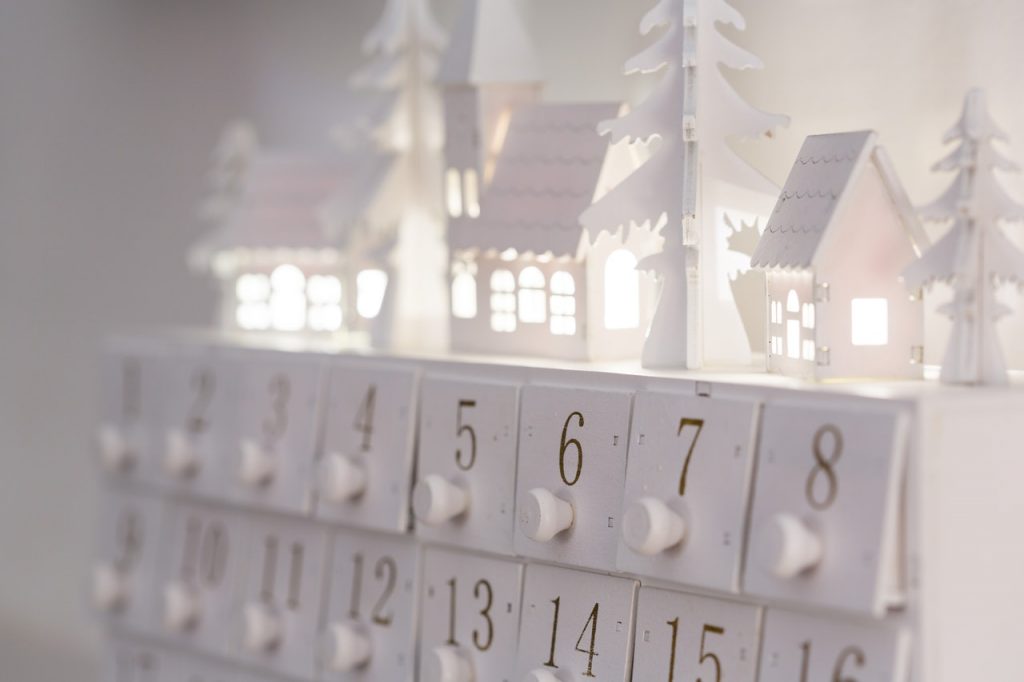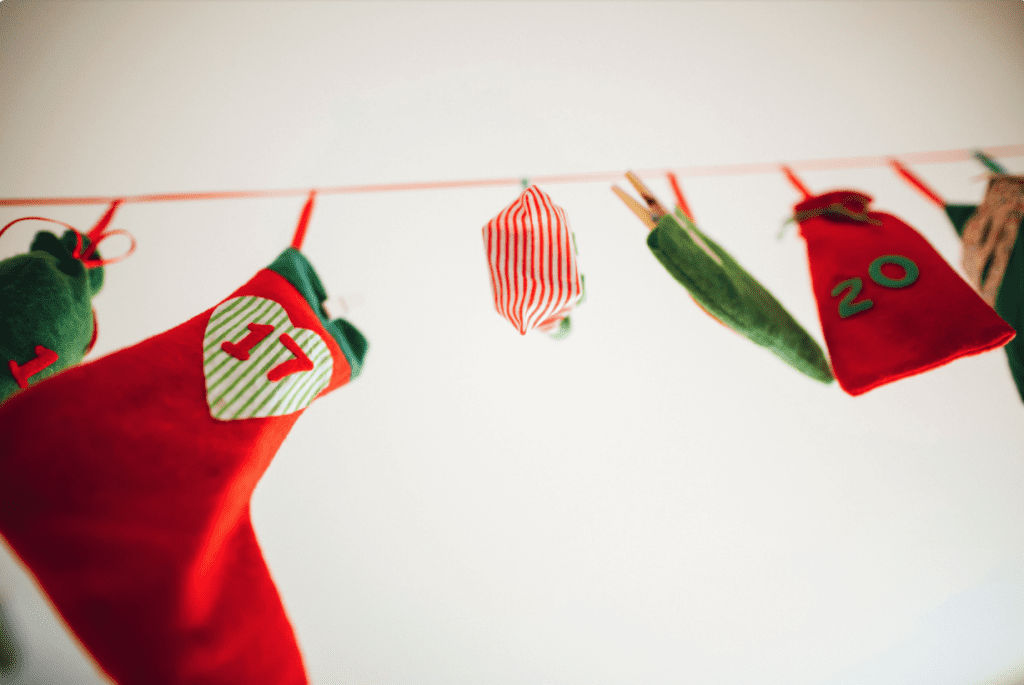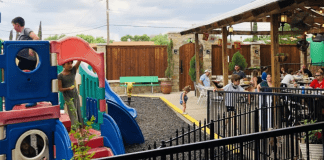This may come as a surprise to you, as it did to me, but there is more to Advent than countdown calendars with tiny chocolates hidden behind numbered cardboard doors. But as I’ve grown older and have sought out holiday traditions to start in my own family, Advent (beyond the countdown calendars) is something I look forward to every year. Whether you’re a religious household or not, an Advent celebration or two is worthy to be placed among your family’s holiday traditions.
What is Advent?
Advent is often described as a period of “expectant waiting.” In a traditional religious sense, this period of waiting calls one to focus on and prepare for the celebration of the Nativity of Christ at Christmas. Essentially, the religious practice of Advent involves patiently and expectantly looking toward the future, while preparing one’s heart for the celebration of Jesus’s birth, which is celebrated on Christmas Day. The exact dates for the Advent season vary between religious denominations, but all cover approximately the same span of time. To make things easy in our family, we begin our Advent countdown on December 1 and continue through Christmas Day, December 25.
While Advent is a very religious practice at its core, a period of expectant waiting and hope for the future is universal. This year could not be a more perfect parallel to Advent’s focus on waiting and longing for the future. I think we can all relate to the hopeful expectancy of the season of Advent:
Waiting for the pandemic and all the trials it brings to come to an end; longing for restored connections with friends, family, and loved ones; feeling expectant that better days are to come.
While we wait for the better days to come (perhaps not so patiently…), we can choose the ways in which we want to celebrate this period of Advent; we can do, be, and focus our attention on the better and higher things we long for. Whether you are religious or not, there are many ways your family can participate in the season of Advent this year.
Religious Advent Celebrations
Our family takes the traditional approach and celebrates Advent in its religious and spiritual context. As a practicing Christian family, we begin our Advent countdown on December 1 through the reading of Scripture as a family, which we will continue for the next 25 days, until our readings culminate with the birth of Jesus. We have used several methods for our religious Advent celebrations over the years.
The Jesus Storybook Bible Advent Guide: We love The Jesus Storybook Bible! It beautifully lays out the Bible in ways young readers and listeners can easily understand, and points every Bible story back to Jesus. The Jesus Storybook Bible Advent Guide is equally beautiful and fun to incorporate with young kids. The free guide download outlines which Scriptures to read each day and gives ideas for Christmas crafts to go along with each daily reading. My kids love working on their crafts as I read the verses to them and we discuss.
Kids Read Truth Advent Conversations Cards: This is our new Advent guide this year. Each day, beginning on December 1, we will read an Advent card, its associated Scripture, and discuss what we read. These cards feature three levels of engagement so everyone can participate: ages 3-5, 6-11, and 12+. Each card also includes a “merry moment” at the end to facilitate light and fun conversations, such as, “Name three of your favorite things about Christmas.” I can’t wait to get started on these cards this year!
DIY Advent: You don’t have to buy anything or follow a prescribed formula to celebrate a religious Advent. There are tons of free Advent guides online to choose from, or you can just do your own thing. One year when my kids were at their most fidgety, I encouraged them to freestyle their own tree ornaments from whatever craft supplies we had on hand while I told them random Bible stories I thought would most capture their short attention spans (hello, Jonah and the Whale, Daniel in the Lion’s Den, and Noah’s Ark). We came to the Christmas story eventually, of course, but in my humble opinion, any biblical truths poured into young souls is well worth the time and effort, Christmas-themed or not. 
Non-Religious Advent Celebrations
Acts of Kindness: It’s always kind to be kind. But being intentional about selecting a specific act of kindness and doing at least one each day is a wonderful way to refresh, renew, and lift your own inner spirit, as well as the spirits of others. There are so many ideas and printables for random acts of kindness available online. My favorite acts of kindness for this particular 2020 Advent season are writing letters and/or drawing pictures to send to loved ones we haven’t been able to visit; checking in our neighbors, especially the elderly ones, and helping them find toilet paper, sanitizer, or other scarce essentials; and caring for the environment with all of our extra outdoor time by disposing of any trash blowing in the wind (but do me a favor and leave those dropped or discarded masks and gloves where they are, unless you are wearing gloves and a mask yourself).
Encourage Mindfulness and Gratitude: To encourage mindfulness throughout the Advent season, you can use tools like mindfulness cards, such as this set from Amazon, or a daily activity book like Mindful Kids. Each day in December, draw a card or choose an activity and practice what it says. If you don’t have cards or a book, another option is to write something you are grateful for on notecards, talk about them with each other, and then display them in a central location for the rest of Advent. (Note: Attaching a chocolate kiss or candy cane to any and all cards is always a great way to get those communication juices flowing!)
Take a Historical Approach: This is such a fun one! Each day throughout the Advent season (basically December), commit to researching and studying the way Christmas is celebrated in different countries and regions across the world. Your kids will love learning about Ded Moroz, the Russian Santa Claus, or the European St. Nicholas. Or study about Kwanzaa or Hanukkah if you don’t already know much about them. One of the best online resources I’ve found for researching different Christmas traditions is www.whychristmas.com. Opening kids’ eyes and hearts to those who believe and celebrate differently from them is vital as we focus on looking forward to a better and brighter future.
Daily Christmas Book Reading: Another super fun way to countdown to Christmas is reading a different Christmas book each day. For this one, simply wrap up 25 Christmas books (these can be from your home collection or local library), and let the kids choose which one to unwrap and read each day. Our personal favorites include ‘Twas the Night Before Christmas, The Polar Express, How the Grinch Stole Christmas, and The Year of the Perfect Christmas Tree.
 Daily Christmas Activities: This option can be as involved or as low-key as you want. Just make a December family calendar of daily Christmas activities and try to stick to it! Options for daily events include decorating gingerbread houses, looking at Christmas lights, watching Christmas movies (obviously we repeat this one several times), hand-making and delivering Christmas cards to neighbors, enjoying a hot chocolate bar as an afternoon snack or nightcap, etc. The festive options for this one are almost endless and can be tailored to meet your family’s needs and schedule.
Daily Christmas Activities: This option can be as involved or as low-key as you want. Just make a December family calendar of daily Christmas activities and try to stick to it! Options for daily events include decorating gingerbread houses, looking at Christmas lights, watching Christmas movies (obviously we repeat this one several times), hand-making and delivering Christmas cards to neighbors, enjoying a hot chocolate bar as an afternoon snack or nightcap, etc. The festive options for this one are almost endless and can be tailored to meet your family’s needs and schedule.
We love combining the elements of religious and non-religious Advent celebrations in our family, and this year will be no exception as we prepare our hearts for the celebration of the birth of Jesus through dwelling on Scripture, as well as waiting expectantly for better days ahead by blasting Christmas music as we drive around looking at Christmas lights and munching on our chocolate treats from countdown calendars.
In what traditional, new, or interesting ways is your family celebrating Advent in 2020?













